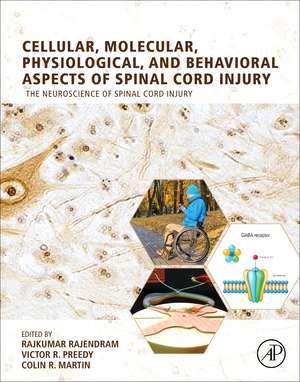Cellular, Molecular, Physiological, and Behavioral Aspects of Spinal Cord Injury
Editat de Rajkumar Rajendram, Victor R. Preedy, Colin R Martinen Limba Engleză Hardback – 11 oct 2022
- Summarizes the neuroscience of spinal cord injury, including cellular and molecular biology
- Contains chapter abstracts, key facts, dictionary, and summary points to aid in understanding
- Features chapters on signaling and hormonal events
- Includes plasticity and gene expression
- Examines health and stress behaviors after spinal cord injury
Preț: 1151.93 lei
Preț vechi: 1496.25 lei
-23% Nou
Puncte Express: 1728
Preț estimativ în valută:
220.45€ • 239.37$ • 185.18£
220.45€ • 239.37$ • 185.18£
Carte disponibilă
Livrare economică 25 martie-08 aprilie
Preluare comenzi: 021 569.72.76
Specificații
ISBN-13: 9780128224274
ISBN-10: 0128224274
Pagini: 556
Ilustrații: Approx. 125 illustrations (125 in full color)
Dimensiuni: 216 x 276 mm
Editura: ELSEVIER SCIENCE
ISBN-10: 0128224274
Pagini: 556
Ilustrații: Approx. 125 illustrations (125 in full color)
Dimensiuni: 216 x 276 mm
Editura: ELSEVIER SCIENCE
Cuprins
Section 1. Setting the Scene: The Spectrum of Spinal Injury
1. Causes of spinal injury: motor vehicle accidents and beyond
2. Global aspects of traumatic spinal injury
3. Economics of traumatic spinal injury
4. Spinal cord injury and the risk of dying
Section 2. Cellular and Molecular Aspects
5. Spectrum of syndromes in spinal injury Central cord syndrome and beyond
6. Neuroinflammation in spinal cord injury
7. Spinal cord injury and cellular excitotoxicity
8. Cytokines and spinal cord injury
9. Cells and spinal cord injury: a focus on glial cells
10. Regenerative response of after spinal injury: propriospinal neurons and beyond
11. Astrocytes in spinal cord injury
12. Linking spinal cord injury and remodeling of the enteric neuromuscular compartment
13. Leukocyte gene expression and spinal cord injury
14. Angiotensin-(1-7) receptor Mas and spinal cord injury
15. Coenzyme Q10, Bax/Bcl2 and Spinal cord injury
16. Signalling pathways in spinal cord injury: a focus on ERK and AKT
17. Wnt signaling in spinal cord injury
18. Gene expression and spinal cord injury: a focus on the motor cortex
19. Glucose metabolism and gene expression in spinal cord injury
20. Receptors in spinal cord injury: a focus on glutamatergic and glycinergic receptors
21. Ion channel and receptors: gene expression and in spinal cord injury
Section 3. Physiological and Metabolic Effects
22. Hormonal events and spinal cord injury: a focus on vasopressin and natriuretic peptide
23. Linking sensorimotor plasticity, the motor cortex and spinal cord injury
24. Spinal cord injury-induced spasticity
25. Effects of spinal cord injury: Cerebral perfusion and autonomic cerebrovascular control
26. Skeletal muscle atrophy in spinal cord injury
27. Bone mass and spinal cord injury: risk of fracture
Section 4. Behavioural and Psychological Effects
28. PTSD and spinal injury
29. Health behaviors after spinal cord injury: alcohol use and beyond
30. Oxidative stress in spinal cord injury
31. Features of endoplasmic reticulum stress: applications to spinal cord injury
32. Health behaviors, people with spinal cord injury
33. Quality of life in cervical traumatic spinal cord injury
34. Empathy in spinal cord injury
35. Daily living measures in spinal cord injury
1. Causes of spinal injury: motor vehicle accidents and beyond
2. Global aspects of traumatic spinal injury
3. Economics of traumatic spinal injury
4. Spinal cord injury and the risk of dying
Section 2. Cellular and Molecular Aspects
5. Spectrum of syndromes in spinal injury Central cord syndrome and beyond
6. Neuroinflammation in spinal cord injury
7. Spinal cord injury and cellular excitotoxicity
8. Cytokines and spinal cord injury
9. Cells and spinal cord injury: a focus on glial cells
10. Regenerative response of after spinal injury: propriospinal neurons and beyond
11. Astrocytes in spinal cord injury
12. Linking spinal cord injury and remodeling of the enteric neuromuscular compartment
13. Leukocyte gene expression and spinal cord injury
14. Angiotensin-(1-7) receptor Mas and spinal cord injury
15. Coenzyme Q10, Bax/Bcl2 and Spinal cord injury
16. Signalling pathways in spinal cord injury: a focus on ERK and AKT
17. Wnt signaling in spinal cord injury
18. Gene expression and spinal cord injury: a focus on the motor cortex
19. Glucose metabolism and gene expression in spinal cord injury
20. Receptors in spinal cord injury: a focus on glutamatergic and glycinergic receptors
21. Ion channel and receptors: gene expression and in spinal cord injury
Section 3. Physiological and Metabolic Effects
22. Hormonal events and spinal cord injury: a focus on vasopressin and natriuretic peptide
23. Linking sensorimotor plasticity, the motor cortex and spinal cord injury
24. Spinal cord injury-induced spasticity
25. Effects of spinal cord injury: Cerebral perfusion and autonomic cerebrovascular control
26. Skeletal muscle atrophy in spinal cord injury
27. Bone mass and spinal cord injury: risk of fracture
Section 4. Behavioural and Psychological Effects
28. PTSD and spinal injury
29. Health behaviors after spinal cord injury: alcohol use and beyond
30. Oxidative stress in spinal cord injury
31. Features of endoplasmic reticulum stress: applications to spinal cord injury
32. Health behaviors, people with spinal cord injury
33. Quality of life in cervical traumatic spinal cord injury
34. Empathy in spinal cord injury
35. Daily living measures in spinal cord injury
